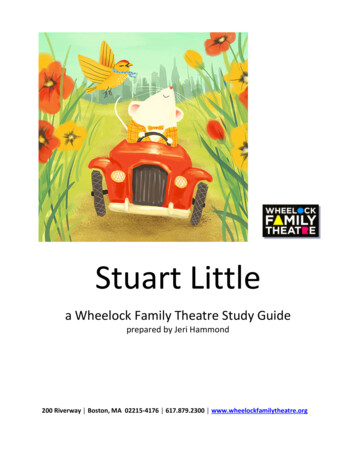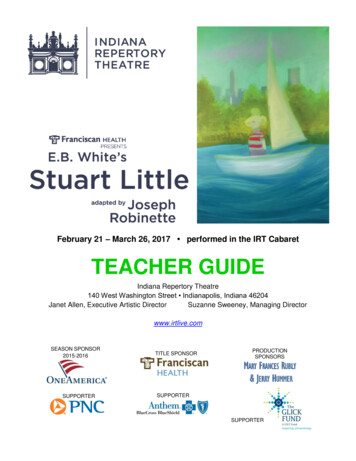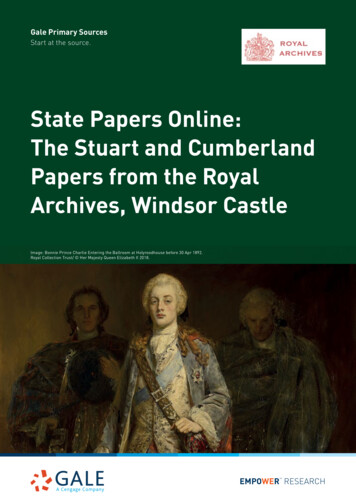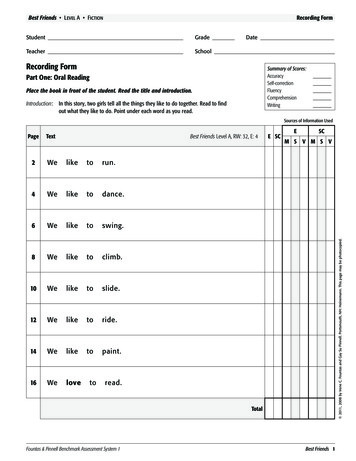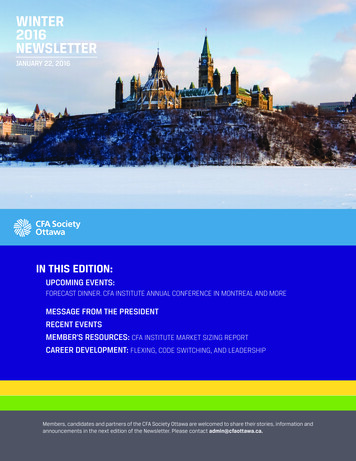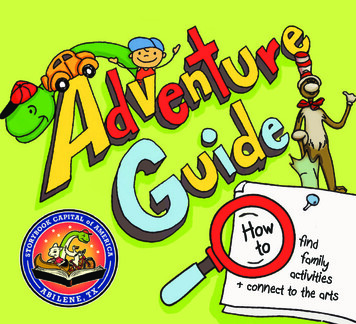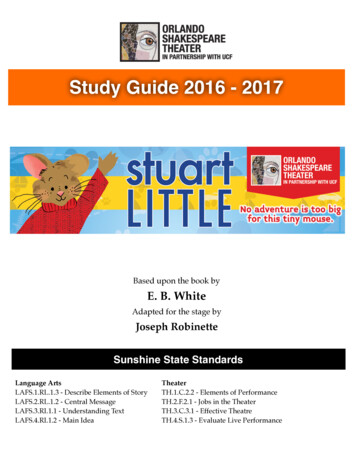
Transcription
Study Guide 2016 - 2017Based upon the book byE. B. WhiteAdapted for the stage byJoseph RobinetteSunshine State StandardsLanguage ArtsLAFS.1.RL.1.3 - Describe Elements of StoryLAFS.2.RL.1.2 - Central MessageLAFS.3.RI.1.1 - Understanding TextLAFS.4.RI.1.2 - Main IdeaTheaterTH.1.C.2.2 - Elements of PerformanceTH.2.F.2.1 - Jobs in the TheaterTH.3.C.3.1 - Effective TheatreTH.4.S.1.3 - Evaluate Live Performance
Stuart LittleTable of ContentsIntroduction . . . . . . . . . . . . . . . . . . . . . . . . . . . . . . . . . . . . . . . . . . . . . . . . . . . 3Enjoying Live TheaterTheater is a Team Sport . . . . . . . . . . . . . . . . . . . . . . . . . . . . . . . . . . . . . . . . . . 4The Actor/Audience Relationship . . . . . . . . . . . . . . . . . . . . . . . . . . . . . . . . . 5About the PlayThe Authors . . . . . . . . . . . . . . . . . . . . . . . . . . . . . . . . . . . . . . . . . . . . . . . . . . . . 6The Playwright. . . . . . . . . . . . . . . . . . . . . . . . . . . . . . . . . . . . . . . . . . . . . . . . . . 6The Characters . . . . . . . . . . . . . . . . . . . . . . . . . . . . . . . . . . . . . . . . . . . . . . . . . 7Summary . . . . . . . . . . . . . . . . . . . . . . . . . . . . . . . . . . . . . . . . . . . . . . . . . . . . . . 7ActivitiesBuilding a Story . . . . . . . . . . . . . . . . . . . . . . . . . . . . . . . . . . . . . . . . . . . . . . . . 8Discussion Questions . . . . . . . . . . . . . . . . . . . . . . . . . . . . . . . . . . . . . . . . . . . . 10Design a Backdrop . . . . . . . . . . . . . . . . . . . . . . . . . . . . . . . . . . . . . . . . . . . . . . 11Friendly Letter Writing . . . . . . . . . . . . . . . . . . . . . . . . . . . . . . . . . . . . . . . . . . 12Tell Us What You Think! . . . . . . . . . . . . . . . . . . . . . . . . . . . . . . . . . . . . . . . . 14image source: movies-in-theaters.net!2
Stuart LittleAn IntroductionEducators:First, let me thank you for taking the time out of your very busy schedule to bring the joy oftheatre arts to your classroom. We at Orlando Shakes are well aware of the demands on yourtime and it is our goal to offer you supplemental information to compliment your curriculumwith ease and expediency.With that in mind, we’ve redesigned our curriculum guides to be more “user friendly.” We’veoffered you activities that you may do in one class period with minimal additional materials.These exercises will aid you in preparing your students to see a production, as well asapplying what you’ve experienced when you return to school. We’ve included Sunshine andCommon Core Standards to assure you that those curriculum needs are being met.It is our hope that by streamlining our guides they will invite you to dip in to grab historicalbackground on an author or playwright, a concise plot summary and colorful characterdescriptions, discussion questions to explore in class or as writing assignments andinteractive activities to bring the magic of live performance back to your classroom. And, ofcourse, how to prepare your students to enjoy live theater.We look forward to hosting you at the Lowndes Shakespeare Theater. Additionally, shouldyou wish to bring our Actor/Educators into your classroom, we will work around yourschedule. Feel free to contact us at Orlando Shakes should you have any questions orsuggestions on how we can better serve you. We are always learning from you.Thank you for your tremendous work in nurturing our audiences of tomorrow.Bravo!Anne HeringDirector of Education!3image source: jrj-socrates.com
Stuart LittleEnjoying Live TheaterTheater is a Team SportThe Playwright writes the script. Sometimes it is from an original idea and sometimes it isadapted from a book or story. The Playwright decides what the characters say, and givesthe Designers guidelines on how the play should look.The Director creates the vision for the production and works closely with the actors,costume, set and lighting designers to make sure everyone tells the same story.Costume DesignerDenise WarnerPhoto: Rob JonesThe Actors use their bodies and voices to bring the author’s words and the director’s ideasto life on the stage.The Designers imagine and create the lights, scenery, props, costumes and sound that willcompliment and complete the director’s vision.The Stage Manager assists the director during rehearsals by recording their instructionsand making sure the actors and designers understand these ideas. The Stage Manager thenruns the show during each performance by calling cues for lights and sound, as well asentrances and exits.Costume ApprenticeSheldon DesmondLamar RobersonPhoto: Rob JonesThe Shop and Stage Crew builds the set, props and costumes according to the designer’splans. The Stage Crew sets the stage with props and furniture, assists the actors withcostume changes and operates sound, lighting and stage machinery during eachperformance.The Front of House Staff welcomes you to the theater, takes your tickets, helps you find yourseat and answers any question you may have on the day of performance.The Theater is where it all takes place. Orlando Shakespeare Theater In Partnership withUCF is the only professional, classical theater company in Central Florida, reachingstudents and audiences in the surrounding eight counties.Mission/Vision:With Shakespeare as our standard and inspiration, the Orlando ShakespeareTheater In Partnership with UCF produces bold professional theater, developsnew plays, and provides innovative educational experiences that enrich ourcommunity. Our vision is to create theater of extraordinary quality thatencourages the actor/audience relationship, embraces the passionate use oflanguage, and ignites the imagination.!4Stage ManagerStacey ReneeNorwoodPhoto: Rob JonesSound DesignerBruce BowesPhoto: Rob Jones
Stuart LittleEnjoying Live TheaterThe Actor/Audience RelationshipThe Audience is the reason Live Theater exists. At Orlando Shakes, we cherish the Actor/Audience relationship, the unique give and take that exists during a performance whichmakes the audience an ACTIVE participant in the event. The actors see the audience just asthe audience sees the actors, and every, laugh, sniffle, chuckle and gasp the audience makeseffects the way the actor plays his next moment. We want you to be engaged, and to live thestory with us!There are certain Conventions of the Theatrical Event, such as when the lights go down, youknow that the show is about to start, and that the audience isn’t encouraged to come and goduring a performance. Here are some other tips to help you and your classmates be top notchaudience members:1. Please make sure to turn off your cell phones. And NO TEXTING!2. Please stay in your seat. Try to use the restroom before you take your seat and stay inyour seat unless there is an emergency.3. Please do not eat or drink in the theater.!5
Stuart LittleAbout the PlayThe AuthorE. B. White, the author of such beloved children's classics as Charlotte's Web,Stuart Little, and The Trumpet of the Swan, was born in Mount Vernon, NewYork. He graduated from Cornell University in 1921 and, five or six yearslater, joined the staff of The New Yorker magazine. E.B. White authored overseventeen books of prose and poetry and was elected to the AmericanAcademy of Arts and Letters in 1973. In addition to writing children's books,E. B. White also wrote books for adults, as well as writing poems and essays,and drawing sketches for The New Yorker magazine. Some of his other booksinclude: One Man's Meat, The Second Tree from the Corner, Letters of E. B.White, The Essays of E. B. White, and Poems and Sketches of E. B. White.Funnily enough for such a famous writer, he always said that he foundwriting difficult and bad for one's disposition but he kept at it!Mr. White has won countless awards, including the 1971 National Medal for Literature and the LauraIngalls Wilder Medal, which commended him for making “a substantial and lasting contribution toliterature for children.”He died on October 1, 1985, and is survived by his son and three grandchildren.“Many years ago,” E.B. White would say, “I went to bed one night in a railway sleeping car, and duringthe night I dreamed about a tiny boy who acted rather like a mouse. That's how the story of Stuart Littlegot started.”Photo and biography courtesy of scholastic.comStuart LittleAbout the PlayThe PlaywrightJoseph Robinette is the author or co-author of 44 published plays and musicalsincluding The Paper Chase, Anne of Green Gables, Stuart Little, The Chocolate War,A Rose for Emily and The Lion, the Witch and the Wardrobe. He collaborated withE.B. White on the authorized stage version of Charlotte's Web, and withcomposer Charles Strouse on the musical version. Robinette's plays have beenpresented by Lincoln Center, the Goodman Theatre, Stage One of Louisvilleand the Honolulu Theatre for Youth. His works have been produced in all 50states and in several foreign countries including Germany, Spain, England andSouth Africa. Robinette is the recipient of numerous awards including theCharlotte B. Chorpenning Award for a distinguished body of work. He is amember of the American Society of Composers, Authors and Publishers and isa founding member of Opera for Youth. In 2002, as professor of theatre at Rowan University, he received theLindback Distinguished Teaching Award for Demonstrated Excellence in the University Classroom.!6
Stuart LittleAbout the PlayThe CharactersStuart LittleMr. LittleMrs. LittleHankStorekeeperGeorgeLeroyAngieMr. ClydesdaleDoctorSnowbellBus DriverDr. CareyZekeBureau ChiefDogMargaloTelephone RepairwomenPigeonHarriet AmesWoman with Newspaper*In this production, sixactors play the twenty onecharacters.image source: jrj-socrates.comStuart LittleAbout the PlaySummaryIn this adaptation, six actors tell the story of Stuart Little. Stuart Little was born to a family ofhumans; however, he looked very much like a mouse! His parents, Mr. and Mrs. Little, loved himlike family. Snowbell, the household cat, is not pleased to have a mouse be part of the family.Stuart's small size makes getting around difficult. As Stuart grows up, he begins to explore. Heexplores the New York City buses and sails toy sailboats. Stuart makes friends with Margalo, thebird. When Angie the cat decides to hunt Margalo, Margalo is forced to flee the Little house. Stuartleaves his home to find Margalo. On his journey, he meets a girl just his size named Harriet. Theygo on a date before Stuart heads further north. As the six actors wrap up the story, we know Stuartfeels like he is headed in the right direction.!7
Stuart LittleActivitiesBuilding a StoryOBJECTIVES:This lesson fosters vocabulary growth, practices prediction skills and speaking to groups, develops creativewriting skills, facilitates collaboration.The student.Demonstrates a basic understanding of internal story grammar.Illustrates the beginning, middle, and end in a story.Collaborates with classmates to create a resolution to the problem posed within the given story.REQUIRED MATERIALS: A short story Chart Paper CrayonsLEAD-IN:The class may be broken into small groups or arranged in a small circle on the floor around the storyteller.Explain to the class that today we are going to learn how to build a story.STEP-BY-STEP: Read a short story, stopping to clearly show any pictures or illustrations to the students. Stop reading about 3/4 of the way through the story. Distribute crayons and the sequencing worksheet provided. Ask the students to illustrate the events that occurred in the beginning and middle of the story. Thesedrawings should be placed in the first and second square on the sheet of paper. In the last square students should draw how they imagine the story will conclude. Have students volunteer to share their conclusions with the rest of the class. Teacher proceeds to finish reading the book so that students can see how the author finished.ASSESSMENTS: Demonstrate a basic understanding of internal story grammar. Use a Story Map to identify and diagram the characters, settings, problems, and solutions within a story. Accurately retells the events in the beginning, middle, and end of a given story.!8
Stuart LittleActivitiesBuilding a StoryName:Date:Title:Event 1: BeginningEvent 1: MiddleEvent 1: EndingUsing this chart, work with your child to illustrate the events that occurred in thebeginning, middle and the end of the short story.!9
Stuart LittleActivitiesDiscussion QuestionsAsking questions that lead children up the“thinking ladder”.Use the following pattern in asking questions:1. Ask OPEN questions to encourage and engage children.2. Ask FOCUSED questions to elicit and organize specificinformation3. Ask CONNECTING questions to help children learn to see therelationships between events, characters and ideas.4. Ask broad questions to help children GENERALIZE/ learn todraw conclusions.5. Accept, record and read all responses on the board, chart oroverhead for all to see.OPEN question examples: What did you notice at the play today .What did you see? What about the play was different from the book/story? What surprised you? What impressed you?FOCUSED questions: (questions that probe children’s’ insights) What did Stuart wish for? ( .) How was his wish granted? ( )ANALYZING/CONNECTING questions: What did Stuart learn about wishes? Why do you think the Stuart wanted to go home?!10image source: classroomclipart.com
Stuart LittleActivitiesDesign a BackdropOBJECTIVES:This lesson fosters imagination, spatial awareness, and fine motor skills. It facilitates collaboration.The student.Demonstrates a basic understanding of set design.Illustrates a backdrop.Collaborates with classmates.1. Imagine New York City is behind Stuart Little.2. What would be behind him? Draw and color what you imagine in the rectangle.3. Compare your drawing to a peer's. What is similar? What is different?*The set designer would give this drawing to the technical director to begin building the set.!11
Stuart LittleFriendly Letter WritingOBJECTIVES:This lesson teaches children the five parts of a friendly letter. After visiting various websites tolearn more about writing friendly letters, your child will be able to write a friendly lettersutilizing the writing process.The student.Uses the writing process to develop friendly letters.Uses the Internet to learn more about writing friendly letters.REQUIRED MATERIALS: Poster board or Paper Markers Examples of friendly letters Computer with internet accessPROCEDURES/ACTIVITIES:1. Visit the following world.com/a lesson/lesson281.shtmlimage source: sketchite.com2. Take time to discuss each part of the letter.Friendly Letter Check ListYESI used capital letters & punctuation correctly.My letter has a headingMy letter has a greetingMy letter has a bodyMy letter has a closingMy letter has a signatureMy letter is ready to be checked by the teacher.!12NO
Stuart LittleActivitiesFriendly Letter Writing1.HeadingNameAddressCity, State, Zip code2. SalutationDear ,3.Body4.ClosingSincerely,5.SignatureYour Name!13
Tell us what you think!After watching the play, write Orlando Shakespeare Theater a “Friendly Letter”and tell us what you think! Tell what you liked or disliked about the story, the characters,costumes, or set. Make sure to use the 5 parts of the letter listed in the lesson and tosupport your thoughts with examples and reasons.Mail to: Orlando Shakespeare TheaterEducation Department,812 E. Rollins Street, Orlando, FL 32803.Teacher and Parent comments are alsoAppreciated!
!6 Joseph Robinette is the author or co-author of 44 published plays and musicals including The Paper Chase, Anne of Green Gables, Stuart Little, The Chocolate War, A Rose for Emily and The Lion, the Witch and the Wardrobe.He collaborated with E.B. White on

